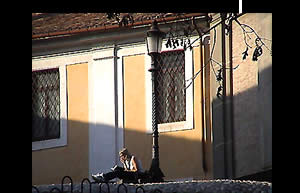|
Italian Language
In Italy, Latin remained the official
written language for many centuries after the fall of the
Roman Empire and was used for diplomacy, by the Church and
in literature. But apart from this learnèd form of
Latin there was also a spoken form that changed constantly
with everyday use and gave rise to many different local variations
that turned into forms of vernacular, the language of the
common people. In the XIIIth cent. the vernacular grew further
and further away from Latin itself to become a separate literary
language: the Cantico delle Creature (Song of All Creatures)
by St. Francis of Assisi was probably written in 1225
and is the earliest poetic work written in Italy’s lyric
vernacular. The new language grew steadily in importance,
chiefly perpetuated by life in the burghs and it was in this
type of cultural background that the ideas and poetry of Dante
blossomed, who wrote the first ever work of poetry in the
Florentine vernacular, the marvellous Divina Commedia (Divine
Comedy), turning him into “the father” of the
Italian language. Latin continued to be used alongside the
vernacular for many centuries to come. Then in 1800, with
Alessandro Manzoni, came the linguistic unification
of Italy and the Italian language was born – a new language
that was not literary but commonplace and comprehensible to
all.
Having shed the austerity of a highly
cultured written language, Italian today is increasingly responsive
to oral language forms and individual modes of expression.
So Italian is constantly adapting and full now of terms that
coin neologisms, regional expressions or particular constructions,
which all convey a sense of semantic usage or emotional values
that are still very much alive today.
Italian is still a highly cultured and
refined language, and immensely stimulating for foreigners
taking an interest in Italy, for study purposes, family traditions
or just out of curiosity. Never before has Italian and the
image of Italy been so highly acclaimed: figures reveal there
are about 200 million people in the world who either speak,
are studying or wish to learn Italian. The Italian language
reflects what Italy is today: a country greatly changed and
still transforming, a country that is not what it used to
be nor as picturesque stereotypes would have it; a country
with positive sides and contradictions too that just keeps
on charming tourists from all over the world!
home
|
|











